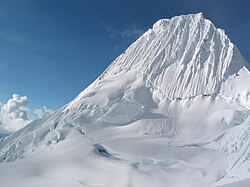| Alpamayo | |
|---|---|
 | |
| Highest point | |
| Elevation | 5,947 m (19,511 ft) |
| Prominence | 524 m (1,719 ft) [1] |
| Parent peak | Quitaraju |
| Coordinates | 08°52.75′S77°39.22′W / 8.87917°S 77.65367°W |
| Naming | |
| Native name | Shuyturaju (Quechua) |
| Geography | |
| Location | Ancash, Peru |
| Parent range | Cordillera Blanca |
| Climbing | |
| First ascent | June 20, 1957, by Günter Hauser, Berhard Huhn and Horst Wiedmann. |
| Easiest route | Difficult snow/ice climb on SW face |
Alpamayo [2] [3] (possibly from Quechua allpa earth, mayu river, [4] "earth river") or Shuyturaju [3] (possibly from Ancash Quechua huytu, shuytu oblong, slim and long, Quechua rahu snow, ice, mountain covered in snow) [5] [6] is one of the most conspicuous peaks in the Cordillera Blanca of the Peruvian Andes. Alpamayo Creek originates northwest of it. [2]
Contents
The Alpamayo lies next to the slightly higher Quitaraju.
In July 1966, the German magazine "Alpinismus", published a photo of Alpamayo taken by American photographer Leigh Ortenburger accompanied by an article on a survey among mountaineering experts, who chose Alpamayo as "The Most Beautiful Mountain in the World". [7]

